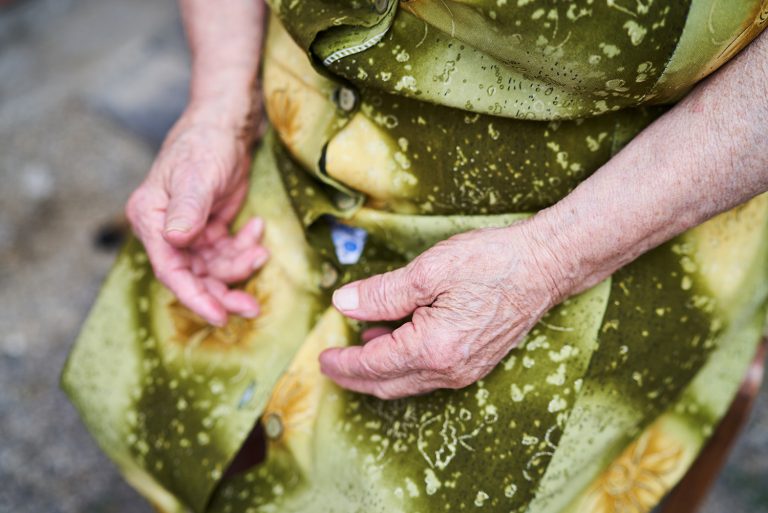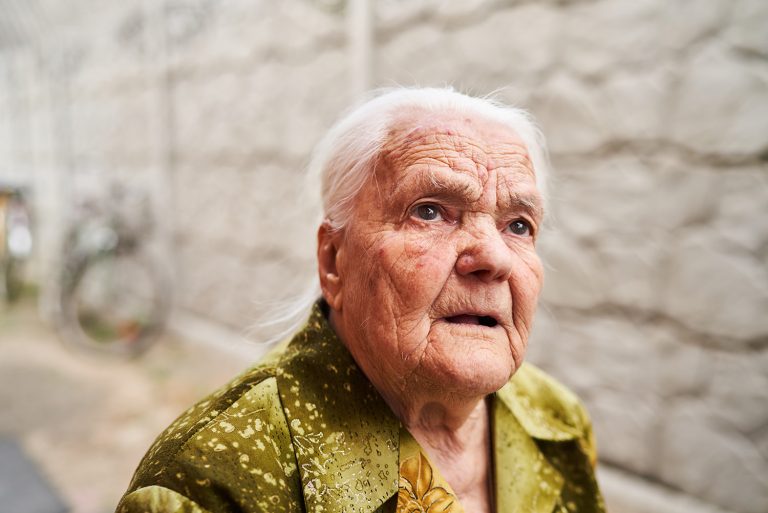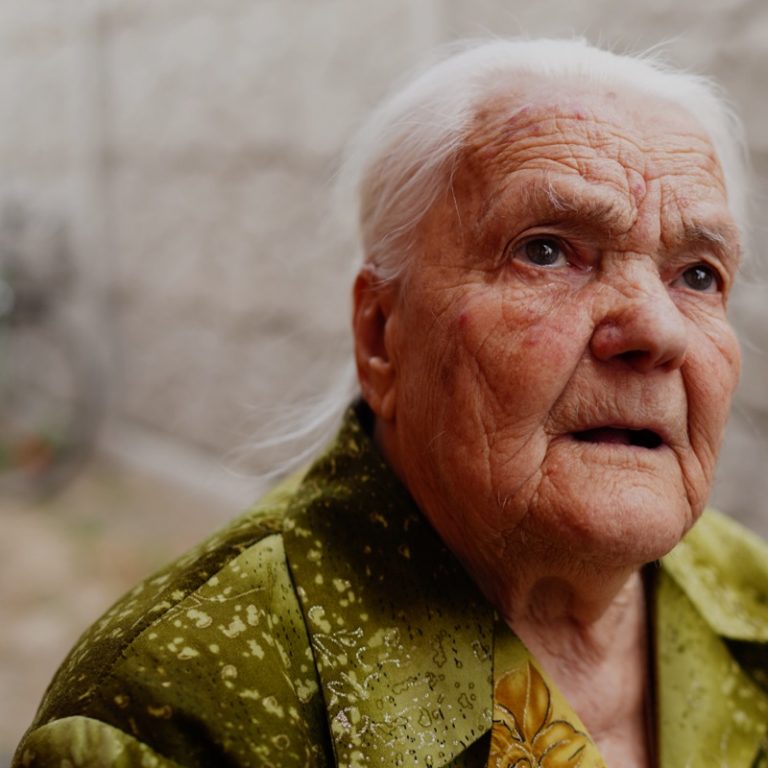Nadiia Korolova was born in the village of Ivankivtsi in Podillia region. When the Holodomor broke out, she was 10 years old. Podillia was among the first regions to start rioting against mass compulsory collectivisation (making villagers forcefully join collective farms, “kolhosps” — ed.) and the closing of churches in 1929. Outraged by the regime’s actions, Ukrainian villagers chased out the local officials and activists from their villages and took control over the district centres. In 1932 the opposition of the rural population reached threatening levels, and the Soviet regime sent military units to suppress the riots. The clashes lasted for days.
The Holodomor of 1932–1933 was the attempt to oppress the farmer rebellions and reaffirm the authority of the Soviet regime. The Holodomor as intentional actions of the Soviet authorities, aimed at the annihilation of the Ukrainian people, fully conforms with the definition of a “genocide”. Seventeen countries have officially recognised the Holodomor as the genocide of the Ukrainian people, 9 countries condemned it as an act of extermination of humanity, and the United Nations recognised it as the national tragedy of the Ukrainian people. In 2008 the Parliamentary Assembly of the Council of Europe recognised the Holodomor as a cruel crime of the Soviet regime against its own people and a crime against humanity.

Wedding photo of the Korolov family, 1952
The family of Nadiia. Collectivisation and dekulakisation
Nadiia’s family was wealthy. Her parents were engaged in farming and were very hard-working; therefore, they managed to accumulate some wealth: 10 hectares of land with a garden and a vegetable plot, a sleigh, a cart, a cow, horses, and sheep. The family lost all of it when the collectivisation commenced.
— When the Soviet rule was established, they took away everything. They emptied our chests, snatched our clothing, rags, and pillows. They took away everything we had in our house. They called it “collectivisation”.
In 1917–1920 the first kolhosps were created, though mass collectivisation unfolded only from 1929. The Soviet authorities sought to transform villagers, who comprised 85% of Ukrainian SSR, into a labour force that could be easily controlled and would succumb to the Bolshevist ideology.
Villagers were forced to relinquish their possessions, livestock, tools, and other belongings to kolhosps. While enlistment in kolhosps was voluntary, less than 10% of the rural population joined them. Those were the poorest layers while the majority preferred to run their own farms.
Compulsory collectivisation began in 1929, and it presupposed forcing all villagers to join kolhosps. Stalin’s policy was aimed at the property of wealthy villagers and its further transference into state-owned assets. Farmers who refused to join kolhosps were classified as “kurkuls” in Ukrainian or “kulaks” in Russian, and were made to pay high in-kind taxes or underwent dekulakisation. It was one of many forms of repression against farmers and people with an active social position. The term “kulak” gained political rather than economic meaning. Ultimately it was used to define those who refused to cooperate with the Soviet regime. During 1928–1931, 1.5 million people suffered from the dekulakisation, the majority of which were exiled to remote regions of the Soviet Union, namely to Siberia.
Siberia
Labour camps were scattered all over Siberia. People were sent there in cold freight cars without food or water. Forty people crammed together travelled like that for a couple of weeks. Upon arrival at the camps, they were doomed to hard work in inhumane conditions.The threat of dekulakisation or arrest made people join kolhosps and yield to directives of the Soviet government. Nadiia recalls that her family hadn’t joined the kolhosp, and so they had to pay the tax.
— My father complied with all demands, he gave them meat and eggs to pay the tax, everything we had. When we claimed that we had nothing else, they took our cow. It was a heifer, so we were preparing it to get bred. They took it for meat. Then they took my father because there was nothing else to take.
To escape the arrest, Nadiia’s father had to sign papers certifying that he would pay one more tax. He signed them but he had nothing to pay with. He had to flee to Luhansk together with several other men and work in mines there. That was a usual practice in those days.

The Holodomor
Nadiia, her mother, four sisters and a brother remained without their breadwinner just a year before the Holodomor broke out. In the winter of 1932, the local authorities began taking away grain and food from people. Their reasoning was the fulfilment of a procurement plan that was set record-high that year in comparison to the previous one. Kolhosps could not meet the set goals and would fail the plan fulfilment. That was why the Soviet government made the villagers relinquish their provisions.
The grain procurement plan
A form of a product duty from villagers to the state according to which they had to supply the state with a specified amount of grain; it was one of the ways to control villagers, their work, and lives.The village council appointed people, often fellow villagers, to form brigades that seized provisions. Some of them joined brigades voluntarily, others were compelled under threat of being purged. Nadiia recalls that the local people were not empathic during the searches.
Patrol Brigades
Special “patrol brigades” were formed out of village activists, kolhosp workers, or the Komsomol (explained below — ed.) members that conducted the searches of households in order to fulfil the procurement plan. The expropriation of grain, food, and livestock was often accompanied by beatings, humiliation, and demolition of the property.— They took away everything and emptied every single pot. They had sticks with sharp metal tips, and they walked with them around a house poking the soil and looking for stashes with grain.
Nadiia remembers that, unlike the villagers, the head of the kolhosp always had food which was mainly confiscated provisions. He trembled for the procurement plan fulfilment since he could lose his job and full-bellied life.
Few people joined kolhosps willingly. According to Nadiia, however, it was nearly the only way to survive, so they did not have much choice. Her elder sister joined the kolhosp in their native village and then moved to a bigger one that had been created in Hnivan, 20 kilometres away.
She would receive two cups of millet a day as her salary and send a portion of food to her family: several cups of grain, a loaf of bread, and other such things. Nadiia’s father also sent some packages from Luhansk.
The family’s livestock was confiscated during the dekulakisation, so in the years of the Holodomor, they ate whatever they could grow or find in the fields. They planted hemp and beets and mashed leaves with millet to cook soup.


slideshow
People collected frozen potatoes that were left in the soil from the previous year. They were peeled and dried, and then ground, and this flour was used to bake flatbread. In kolhosps, there were outdoor piles of harvest covered with straw or soil for long-term storage. People uncovered potato piles, peeled potatoes and ground them into flour. They made pancakes out of them that tasted “normal just because they had salt”.
Nadiia’s family had no millstones, and they had to grind everything using a big clay bowl with a rough surface for grinding and creaming. Some of their neighbours managed to keep their millstones. Today millstones are material proof of the genocide since the Soviet regime confiscated and destroyed them so that Ukrainians had no tools to grind grain.
Nadiia recalls that there was a woman in their village that collected wheat ears and got convicted to 5 years in prison according to the resolution “On Safekeeping the Property of State Enterprises, Collective Farms and Cooperatives, and Strengthening Public (Socialist) Property,” which the people called “The Law of Five Ears of Grain”. In Nadiia’s village, nobody dared go to the field as everyone was scared.
— The new rule was established. May no one ever know of it again! We managed to survive the Holodomor. I still wonder how we did it: there were five children, our mother, and a baby. My mother had nothing to eat herself yet still breastfed the baby.
Nadiia’s sister perished from hunger. Other family members survived.
— Our sister had died, and shortly our father wrote a letter, “What has happened at home? I had a dream that I severely hit my little finger.” We answered, “Tania died.” It was in 1933. We made a crate and buried the child.
After the Holodomor
Nadiia’s father returned from Luhansk after the Holodomor and joined the kolhosp to escape imprisonment. He worked with other men taking care of oxen.
— They did all kinds of work. They went very early to work to feed oxen, then they used carts to transport grain and sheaves, to take straw to stacks. They worked as hard in the kolhosp as they used to work for themselves.
In the meantime, ethnic Russians were resettled to the cities in Donbas to continue development of the industrial sector in the region. Workers for mines were recruited all over Ukraine, and in order to avoid such hard labour, Nadiia followed her sister’s advice and applied to membership in the Komsomol.
Komsomol
An abbreviation for “Komunistychnyi Soiuz Molodi”, or the Communist Union of Youth in the USSR. The regime used it to involve young people in the implementation of state campaigns.
Nadiia. 24 years old.
— I filled out an application and joined the Komsomol because I was scared about being taken to Donbas, but the Komsomol members could escape it. When I got accepted there was a new kolhosp organized, and they needed to arrange a unit of workers for a 5-hectare plot of the kolhosp land. They decided to appoint me as a unit head.
Nadiia remembers that together with the young women that she organized into a unit they managed to grow 50,000 kg of beet per hectare. She was just 15 years old back then, and it was only a couple of years after the Holodomor.
Villagers were very poor after the Holodomor, and everyone did their best to survive. There were cases when fellow villagers abused each other’s trust to get necessary food or goods. Once when Nadiia’s sister was standing in line to buy some fabric in a village store in Hnivan, she met a woman from her native village.
— She came up to my sister and said, “Ksenia, your father died!” So my sister left the line, and that woman took her place. Ksenia ran outside and saw a man from our village. She approached him and asked about our father. He said, “No, it’s not true because I met him today. He was on his way to harness oxen, and I was on my way to Hnivan.”
Later on, Nadiia’s sister tried to find the pillows that were confiscated during the dekulakisation. Everyone knew that activists either appropriated confiscated clothing and other belongings or sold them to each other since villagers had no money. Nadiia’s sister found those pillows, they were sold for two, three, or five rubles, but they were in very poor condition.
Demolition of a church
The new Soviet ideological system had no room for religion. From 1925 to 1929 under the pressure of the regime and threat of high taxes, dekulakisation, and arrests, more than 2000 priests abdicated. In 1929 the first bells were removed from churches, allegedly for the needs of industrialisation.
The wooden church in Ivankivtsi village, where Nadiia’s grandfather was a warden, was closed down before the Holodomor, and then it was taken down.

Village church. 1933. Photo from the private archive of Mykola Borysovych Oksiuta. Unknown author.
— There was a man, they say, who stomped on the icons, and he also took floorboards from the church and laid the floor with them at his house. That floor decayed almost at once. The rest of the boards were taken to the store. And guess what? The section of the floor they made earlier was fine, but the section made out of church boards burnt down.
The second Soviet five-year plan was proclaimed as “five years of religion destruction”. The churches were not simply closed down but rather destroyed. Often church buildings were turned into warehouses. Nadiia recalls that at the spot of the destroyed church, a school was built after a while.
After the church was taken down, the fellow villagers held church services in the priest’s house while the priest himself had to leave the village due to the pressure of the Soviet regime. Despite being prohibited, the people in the village continued observing Christmas and Easter.
The Holodomor as a genocide of Ukrainian people ruined many lives. A great number of people attempted to fight against the Soviet reign of terror. Some did not withstand, could not resist it, and did not survive. The memory of those horrible years is brought to us by eye-witnesses. They share their recollections with Ukrainians and the whole world so that people would never forget.
— I feel very sorry. I told my family about all of it, and my son-in-law said, “I would shoot them.” And I replied, “You would do nothing because they would shoot you before you could kill anyone.” No one could say anything. No one. We just watched.


